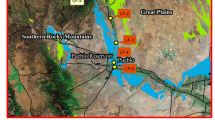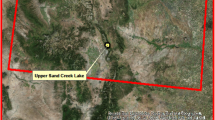Abstract
The Yankee Fork is a large tributary of the Salmon River located in central Idaho, USA, with an extensive history of placer and dredge-mining activities. Concentrations of selenium (Se) and mercury (Hg) in various aquatic trophic levels were measured in the Yankee Fork during 2001 and 2002. Various measurements of fish health were also performed. Sites included four on the mainstem of the Yankee Fork and two off-channel sites in partially reclaimed dredge pools used as rearing habitat for cultured salmonid eggs and fry. Hg concentrations in whole mountain whitefish and shorthead sculpin ranged from 0.28 to 0.56 μg/g dry weight (dw), concentrations that are generally less than those reported to have significant impacts on fish. Biofilm and invertebrates ranged from 0.05 to 0.43 μg Hg/g dw. Se concentrations measured in biota samples from the Yankee Fork were greater than many representative samples collected in the Snake and Columbia watersheds and often exceeded literature-based toxic thresholds. Biofilm and invertebrates ranged from 0.58 to 4.66 μg Se/g dw. Whole fish ranged from 3.92 to 7.10 μg Se/g dw, and gonads ranged from 6.91 to 31.84 μg Se/g dw. Whole-body Se concentrations exceeded reported toxicological thresholds at three of four sites and concentrations in liver samples were mostly greater than concentrations shown to have negative impacts on fish health. Histological examinations performed during this study noted liver abnormalities, especially in shorthead sculpin, a bottom-dwelling species.


Similar content being viewed by others
References
Blazer VS, Fournie JW, Wolf JC, Wolfe MJ (2006) Diagnostic criteria for proliferative hepatic lesions in brown bullhead Ameiurus nebulosus. Dis Aquat Organ 72:19–30
Brumbaugh WG, Walther MJ (1989) Determination of arsenic and selenium in whole fish by continuous-flow hydride generation atomic absorption spectrophotometry. J Assoc Off Anal Chem 72(3):484–486
Brumbaugh WG, Walther MJ (1991) Improved selenium recovery from tissue with modified sample decomposition. J Assoc Off Anal Chem 74(3):570
Clark GM, Maret TR (1998) Organochlorine compounds and trace elements in fish tissue and bed sediments in the lower Snake River basin, Idaho and Oregon. Water Resources Investigations Report 98-4103, United States Geological Survey, Boise
DeForest DK, Brix KV, Adams WJ (1999) Critical review of proposed residue-based selenium toxicity thresholds for freshwater fish. Hum Ecol Risk Assess 5:1187–1228
Dillard CJ, Tappel AL (1984) Fluorescent damage products of lipid peroxidation. Methods Enzymol 105:337–341
Dillon T, Beckvar N, Kern J (2010) Residue-based mercury-dose response in fish: an analysis using lethality equivalent test endpoints. Environ Toxicol Chem 29(11):2559–2565
Farag AM, Stansbury MA, Hogstrand C, MacConnell E, Bergman HL (1995) The physiological impairment of free-ranging brown trout exposed to metals in the Clark Fork River, Montana. Can J Fish Aquat Sci 52:2038–2050
Farag AM, Woodward DF, Goldstein JN, Brumbaugh W, Meyer JS (1998) Concentrations of metals associated with mining waste in sediments, biofilm, benthic macroinvertebrates, and fish from the Coeur d’Alene River basin, Idaho. Arch Environ Contam Toxicol 34:119–127
Farag AM, Skaar D, Nimick DA, MacConnell E, Hogstrand C (2003) Characterizing aquatic health using salmonid mortality, physiology, and biomass estimates in streams with increased concentrations of arsenic, cadmium, copper, lead, and zinc in the Boulder River watershed, Montana. Trans Am Fish Soc 132:450–467
Fjeld E, Haugen TO, Vǿllestad LA (1998) Permanent impairment in the feeding behavior of grayling (Thymallus thymallus) exposed to methylmercury during embryogenesis. Sci Total Environ 213:247–254
Frost TP, Box SE (2009) Stream-sediment geochemistry in mining-impacted drainages of the Yankee Fork of the Salmon River, Custer County, Idaho. United States Geological Survey, Scientific Investigations Report 2008-5115, Reston, VA. http://pubs.usgs.gov/sir/2009/5115/. Accessed 4 Aug 2012
Goede RW (1989) Fish health/condition assessment procedures, part 1. Utah Division of Wildlife Resources. Fisheries Experiment Station, Logan
Green DE, Albers PH (1997) Diagnostic criteria for selenium toxicosis in aquatic birds: histologic lesions. J Wildl Dis 33:385–404
Grieb TM, Driscoll CT, Gloss SP, Schofield CL, Bowie GL, Porcella DB (1990) Factors affecting mercury accumulation in fish in the Upper Michigan Peninsula. Environ Toxicol Chem 9:919–930
Hamilton SJ (2002) Rationale for a tissue-based selenium criterion for aquatic life. Aquat Toxicol 57:85–100
Hamilton SJ (2003) Review of residue-based selenium toxicity thresholds for freshwater fish. Ecotoxicol Environ Saf 56:201–210
Hillwalker WE, Jepson PC, Anderson KA (2006) Selenium accumulation patterns in lotic and lentic aquatic systems. Sci Total Environ 366(1):367–379
Hinck JE, Schmitt CJ, Bartish TM, Denslow ND, Blazer VS, Anderson PJ et al (2004) Biomonitoring of environmental status and trends (BEST) program: environmental contaminants and their effects on fish in the Columbia River basin. Scientific Investigations Report 2004-5154, United States Geological Survey, Columbia
Hoffman DJ, Heinz GH (1998) Effects of mercury and selenium on glutathione metabolism and oxidative stress in mallard ducks. Environ Toxicol Chem 17:161–166
Hoffman DJ, Ohlendorf HM, Marn HM, Pendleton GW (1998) Association of mercury and selenium with altered glutathione metabolism and oxidative stress in diving ducks from the San Francisco Bay region, USA. Environ Toxicol Chem 17:167–172
Janz DM, DeForest DK, Brooks ML, Chapman PM, Gilron G, Hoff D et al (2010) Selenium toxicity to aquatic organisms. In: Chapman PM, Adams WJ, Brooks ML, Delos CG, Luoma SN, Maher WA et al (eds) Ecological assessment of selenium in the aquatic environment. SETAC Press, Pensacola
Jewett SC, Kelley JJ, Dasher D, Duffy LK, Zhang X, Sathy Naidu A (2003) Comparison of mercury and methylmercury in northern pike and arctic grayling from western Alaska rivers. Chemosphere 50:383–392
Lemly AD (1993) Guidelines for evaluating selenium data from aquatic monitoring and assessment studies. Environ Monit Assess 28:83–100
Lemly AD (1996) Selenium in aquatic organisms. In: Beyer WN, Heinz GH, Redmon-Norwood AW (eds) Environmental contaminants in wildlife: interpreting tissue concentrations. CRC Press, Boca Raton
Lemly AD, Smith GJ (1987) Aquatic cycling of selenium: implications for fish and wildlife. Fish and Wildlife Leaflet 12. United States Fish and Wildlife Service, Washington DC
Maret TR (1995) Mercury in streambed sediment and aquatic biota in the upper Snake River basin, Idaho and western Wyoming, 1992. United States Geological Survey Water Fact Sheet, Open File Report, FS-089-95, United States Geological Survey, Boise
Mason RP, Laporte JM, Andres S (2000) Factors controlling the bioaccumulation of mercury, methylmercury, arsenic, selenium, and cadmium by freshwater invertebrates and fish. Arch Environ Contam Toxicol 38:283–297
Morris JS, Spate VL (2003) The measurement of selenium status in Missouri using the toenail biomarker analyzed by instrumental neutron activation analysis. Am J Epidemiol 24(11):S6–S6 Meeting Abstract
Ohlendorf HM (2003) Ecotoxicology of selenium. In: Hoffman DJ, Rattner BA, Burton GA Jr., Cairns J Jr. (eds) Handbook of ecotoxicology. Lewis, Boca Raton
Orr PL, Guiguer KR, Russel CK (2006) Food chain transfer of selenium in lentic and lotic habitats of a western Canadian watershed. Ecotoxicol Environ Saf 63(2):175–188
Peterson SA, Herlihy AT, Hughes RM, Motter KL, Robbins JM (2002) Level and extent of mercury contamination in Oregon, USA, lotic fish. Environ Toxicol Chem 21:2157–2164
Presser TS, Luoma SN (2010) A methodology for ecosystem-scale modeling of selenium. Integr Environ Assess Manag 4(4):685–710
Sandheinrich MB, Wiener JC (2010) Methylmercury in freshwater fish: recent advances in assessing toxicity of environmentally relevant exposures. In: Beyer WN, Meador JP (eds) Environmental contaminants in biota: interpreting tissue concentrations, 2nd edn. CRC Press, Boca Raton
SAS Institute (1999) Statistical Analysis System (SAS) statistics user’s guide. SAS Institute, Cary, NC, USA
Scott WB, Crossman EJ (1998) Freshwater fishes of Canada. Galt House, Oakville
Skorupa JP, Morman SP, Sefchick-Edwards JS (1996) Guidelines for interpreting selenium exposures of biota associated with nonmarine aquatic habitats. Sacramento, CA. United States Fish and Wildlife Service, Sacramento Field Office, Technical Report
United States Environmental Protection Agency (2001) Fish tissue criteria for the protection of human health: methyl mercury. EPA-823-R-01-001, Washington DC. http://www.epa.gov/waterscience/criteria/methylmercury/. Accessed 15 May 2006
United States Environmental Protection Agency (2003) Mercury in solids and solutions by thermal decomposition, amalgamation, and atomic absorption spectrophotometry. http://www.epa.gov/osw/hazard/testmethods/sw846/pdfs/7473.pdf. Accessed 15 May 2006
Weis JS (2009) Reproductive, developmental, and neurobehavioral effects of methylmercury in fishes. J Environ Sci Health C Environ Carcinog Ecotoxicol Rev 24(4):212–225
Wiener JG, Spry DJ (1996) Toxicological significance of mercury in freshwater fish. In: Beyer WN, Heinz GH, Redmon-Norwood AW (eds) Environmental contaminants in wildlife: interpreting tissue concentrations. CRC Press, Boca Raton
Wiener JG, Krabbenhoft DP, Heinz GH, Scheuhammer AM (2003) Ecotoxicology of mercury. In: Hoffman DJ, Rattner BA, Burton GA Jr., Cairns J Jr. (eds) Handbook of ecotoxicology. Lewis, Boca Raton
Wolford C (1999) Land of the Yankee Fork. Trailer Life 59(6):36
Zar JH (1999) Biostatistical analysis, 4th edn. Prentice-Hall, Upper Saddle River
Acknowledgments
The authors thank Steve Olson and Alan Alert, USGS, and Joseph Vacirca, David Herron, Tom Montoya, Julia Markham, and Shawna Johansen, United States Forest Service, for assistance with sample collections; Tom May, Jesse Arms, and Mike Walther for assistance with element analyses; and Brad Mueller for assistance with LP. Reviews of an earlier version of this manuscript were provided by Kevin Buhl, John Besser, Dean Morgan, and USFS consultants.
Author information
Authors and Affiliations
Corresponding author
Rights and permissions
About this article
Cite this article
Rhea, D.T., Farag, A.M., Harper, D.D. et al. Mercury and Selenium Concentrations in Biofilm, Macroinvertebrates, and Fish Collected in the Yankee Fork of the Salmon River, Idaho, USA, and Their Potential Effects on Fish Health. Arch Environ Contam Toxicol 64, 130–139 (2013). https://doi.org/10.1007/s00244-012-9816-x
Received:
Accepted:
Published:
Issue Date:
DOI: https://doi.org/10.1007/s00244-012-9816-x




